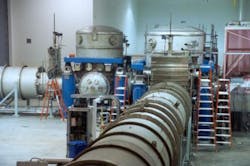Advanced Laser Interferometer Gravitational-wave Observatory (LIGO) dedicated
The Advanced LIGO project, a major upgrade that will increase the sensitivity of instruments at the Laser Interferometer Gravitational-wave Observatories (LIGOs) by a factor of ten and provide a 1000-fold increase in the number of astrophysical candidates for gravitational-wave signals, was officially dedicated in a ceremony held at the LIGO Hanford facility in Richland, Washington.
LIGO was designed and is operated by Caltech (Pasadena, CA) and MIT (Cambridge, MA) with funding from the National Science Foundation (NSF). Advanced LIGO, also funded by the NSF, will begin its first searches for gravitational waves in the fall of this year.
"We've spent the past seven years putting together the most-sensitive gravitational-wave detector ever built," says Caltech's David Reitze, executive director of the LIGO project. "Commissioning the detectors has gone extremely well thus far, and we are looking forward to our first science run with Advanced LIGO beginning later in 2015."
LIGO is aimed at detecting gravitational waves emitted by binary pulsars and other cosmological objects. According to Einstein's theory, the relative distance between the LIGO interferometers' mirrors will change very slightly when a gravitational wave passes by.
Sensitivity of 10-19 mThe original configuration of LIGO was sensitive enough to detect a change in the lengths of the 4 km arms by about 10-18 m. Advanced LIGO, which will utilize the infrastructure of LIGO, will have a 10-19 m sensitivity.
Included in the upgrade were changes in the lasers (180 W highly stabilized diode-pumped Nd:YAG systems), optics (40 kg fused-silica test mass mirrors suspended by fused-silica fibers), seismic isolation systems (using inertial sensing and feedback), and in how the nanoscopic motion (less than one femtometer) of the test masses is detected.
The change of more than a factor of 10 in sensitivity also comes with a significant increase in the sensitive frequency range. This will allow Advanced LIGO to look at the last minutes of the life of pairs of massive black holes as they spiral closer, coalesce into one larger black hole, and then vibrate much like two soap bubbles becoming one. It will also allow the instrument to pinpoint periodic signals from the many known pulsars that radiate in the range from 500 to 1000 Hz.
Advanced LIGO will also be used to search for the gravitational cosmic background, allowing tests of theories about the development of the universe only 10 to 35 seconds after the Big Bang.
Sources:

John Wallace | Senior Technical Editor (1998-2022)
John Wallace was with Laser Focus World for nearly 25 years, retiring in late June 2022. He obtained a bachelor's degree in mechanical engineering and physics at Rutgers University and a master's in optical engineering at the University of Rochester. Before becoming an editor, John worked as an engineer at RCA, Exxon, Eastman Kodak, and GCA Corporation.
